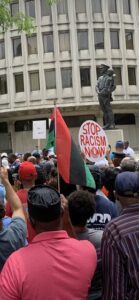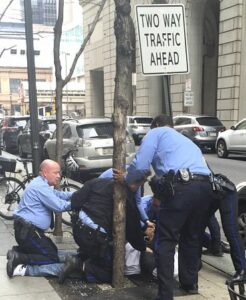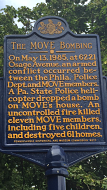Over two decades ago Philadelphia’s then top prosecutor made an observation applicable to recent actions by many members of the Philadelphia Police Department.
Those recent foul actions include the fatal police shooting of a mentally ill man and the vicious police beating of a woman and her teenage nephew that also traumatized this woman’s two-year-old son.

That prosecutor’s observation in the 1990s, triggered partly by the intransigent culture of brutality among too many Philadelphia police officers, stated: “When police are indistinguishable from the bad guys, then society has a serious problem.”
The ‘bad guy’ police action in the recent fatal shooting of 27-year-old Walter Wallace Jr., during a mental health crisis, seemingly violated procedure contained in the Police Department’s Directive 10.9. That Directive is an operations document that details how to handle severely mentally disabled persons.
Two policemen shot Wallace 14-times in front of his mother who had called 911 for an ambulance to assist her son…but those two officers arrived first.
Procedures for handling severely mentally disabled persons detailed in Directive 10.9 call for de-escalation and pointedly bar police from “aggressive action.”
However, those two officers shunned de-escalation instead barking commands that Wallace surrender immediately. Those officers ignored pleas from Wallace’s mother and others that Wallace was mentally ill.
‘Bad guys’ don’t follow rules, like procedures detailed in Directive 10.9.
Procedures stated in just the first few provisions of Directive 10.9 note that if police commands are insufficient to deescalate the situation, then police use “Intermediate Force” before resorting to “Deadly Force.”
Intermediate Force includes use of batons, mace and/or Tasers. The two officers who shot Wallace did not employ any intermediate force devices before deadly force: firing their guns according to cell phone videos of that disturbing incident.
Incredibly, Philadelphia Police Department officials acknowledged the officers who shot Wallace did not have Tasers because the Department could not afford to equip all officers with such devices. The current budget for that Department is over $700-million dollars.
While police made no attempt to use batons to dislodge a small knife from Wallace’s hand, a swarm of ‘bad guy’ acting police did use their batons to brutally beat 28-year-old Rickia Young and her 16-year-old nephew. During that inexcusable assault on Young, police used batons to smash the windows of Young’s SUV, showering shards of glass on her toddler.
Young had inadvertently found herself in the middle of civil unrest from the fatal shooting of Wallace while driving home from West Philadelphia, the section of the city where Wallace was shot.
Young unknowingly turned onto a street barricaded by police. When Young attempted to back out of that barricaded street, a mob-like group of cops swarmed her SUV, wildly smashing the windows before snatching her and her nephew from the SUV beating them to the ground.
The fatal police shooting of Wallace and the unprovoked police savaging of Young are under investigation according to Philadelphia’s Police Commissioner, Danielle Outlaw – an African American female appointed in December 2019 from a similar post in Portland, Oregon.
This is the same Commissioner Outlaw now conducting investigations into such police activities in recent months as shooting rubber bullets and dropping tear gas from a helicopter on peaceful anti-police brutality protestors corralled on a highway and multiple protective interactions by police officers with violent racists from the Proud Boys to neighborhood vigilantes.
Philadelphia is a city with a putrid history of repeated incidents of police brutality, dating back over a century, much of it stained by racism.
A 1998 report on police brutality by the Human Rights Watch organization stated repeated police brutality scandals earned Philadelphia police “one of the worst reputations of big city police departments in the United States.” That HRW report began with that ‘bad guy’ observation by Philadelphia’s then top prosecutor.
Many of the bloody encounters on Philadelphia’s unwritten “Ugly List Of Police Brutality” occurred in West Philadelphia.

In August 2011, police beat a blind man on a West Philly street corner ignoring shouted pleas from bystanders that the man was blind. Officers claimed that Darrell Holloway – legally blind in both eyes – attacked them and even chased after officers during that nighttime attack.
If police accounts of that incident were accurate, the blind Holloway apparently employed some kind of superhuman sonar to locate officers and then punch officers.
Police charged Holloway with assault. During Holloway’s trial, he had to remove his prosthetic eye in front of the jury to counter police testimony that the inoperative device was actually a functioning eyeball. Holloway won acquittal. Authorities took no action against the policemen who beat Holloway and then lied in court.
In June 2005, not far from the site of Wallace’s death in West Philadelphia, police fatally chocked a suspected drug dealer during an alleged attempt to get the dealer cough-up drugs police claimed he shallowed.
During a protest held a few days after that 2005 choking death of Scharoon “Fat Daddy” Coachman, police beat one protester unconscious in an unprovoked attack. Police falsely charged that protester with assault on police. That false charge against protester Ernest Ford produced a wrongful conviction of Ford. Ironically, a few months before the false arrest, Ford received a commendation from the Governor of Pennsylvania for his community activism.
In June 1992, eight police officers fired 90 shots into the West Philadelphia home of Charles Matthews. The shooting spree started when one officer inadvertently shot another officer leading officers to believe Matthews was the shooter. A grand jury recommended charges against all eight officers’, but a judge dismissed the grand jury’s recommendation. One of those officers became the head of the PPD Homicide Division and another became Philly’s top cop – the PPD Commissioner.
Also, three blocks from the site of Wallace’s death, is the scene of arguably the worst police brutality incident in American history. That was the May 1985 police bombing of the radical group MOVE, a horrific incident that killed 11 MOVE members including five children and destroyed 61 homes in an inferno ignited by that bomb. Before police dropped the bomb, they fired 10,000 bullets into the house occupied by barricaded MOVE members.
Local and federal prosecutors found no fault in that police misconduct that incinerated 11 people and left 250 Black people homeless.
With the sordid shooting of Walter Wallace Jr., the first sentence of the first paragraph of PPD Directive 10.9 states “the main objective when handling a “Severely Mentally Disabled Person” is to aid and protect the interests of [that person] …”
The last sentence of that first paragraph states that achievement of the objective to aid-&-protect is “best accomplished by DE-ESCALATING THE INCIDENT AND CONTAINING AND ISOLATING the individual.”
Cell phone video of the fatal shooting of Wallace shows little de-escalation or attempts at isolation beyond two officers barking orders. Police back into the street still shouting for Wallace to drop the knife and get on the ground. Although Wallace was a distance from the officers, when he continued to walk forward, officers opened fire – citing the worn claim of fearing for their lives.
Bystanders say Wallace posed minimal danger to the two officers.

The third paragraph of Directive 10.9 informs that “People with mental illnesses are usually frightened, and want to get away not attack.”
The fourth page of Directive 10.9 reminds police that “Retreating or re-positioning is not a sign of weakness or cowardice by an officer, it is often a tactically superior police procedure rather than the immediate use of force.”
When those officers repositioned, still at a distance from Wallace, they went into a firing stance and unleashed a barrage of shots into Wallace.
The first sentence of the second paragraph of Directive 10.9 clearly states that “Time is of no importance when handling” severely mentally disabled persons. The second sentence of the second paragraph states “Aggressive action will not be taken by police.”
Many outside law enforcement view shooting a person in the midst of a mental health crisis as an aggressive action.
Philadelphia authorities are spinning a narrative that the officers who shot Wallace lacked adequate training – a stance in conflict with procedures clearly delineated in Directive 10.9.
Further, since at least the late 1970’s, Philadelphia authorities have waved the lack-of-training excuse to elude serious liability for errant acts by officers during encounters with citizens suffering mental health crises.
Authorities currently massage their nonsensical lack-of-training narrative in the Wallace shooting with 911 data that the responding officers were not informed of Wallace’s mental condition.
While the 911 data contained in media accounts did not specifically alert responding officers of Wallace’s condition, Wallace’s mother and bystanders repeatedly told those two officers about Wallace’s condition. That 911 alert curiously did not reference previous 911 calls that day seeking assistance for Wallace.
The vicious beating of Rickia Young clearly exhibits police behavior “indistinguishable from the bad guys” as noted in that 1998 HRW report.
The fatal shooting of Wallace and the violent assault on Young compound what that 1998 HRW report also noted: “minority communities are distrustful of police officers who too often act like criminals.”
